This post contains affiliate links. We earn commissions if you purchase products from retailers after clicking on a link from our site. As an Amazon Associate, we earn from qualifying purchases.
There’s a lot of lists floating around about easy instruments to learn–well, this one is going to be all about instruments that are not only easy, but inexpensive. After all, even if piano is considered easy to learn by some–that’s not very inexpensive!
I’m going to be talking about brand new instruments–you can probably find old pianos for free or less than $500–or perhaps an old tarnished trumpet at a flea market for $50, but that would widen the discussion too broadly. Just know that most instruments are within everyone’s reach if you are willing to look at getting it secondhand.
Looking for small instruments in particular? I list out 33 small instruments that can fit in your pocket, here.
I’ll be focusing this post, however, on instruments that you can buy new that are inexpensive and easy to learn. How do I have any say as to what is easy to learn?
By the way, looking for a place to buy inexpensive instruments? Check out Amazon.com for some inspiration–I have listed out in much more detail in this post some ideas, so if you combine both of these resources, you’ll be all set. 🙂
For the year of 2020, I set a goal to learn a different instrument every month, practicing an hour each day. I started in 2019, so by the end of the year I will have studied 14 instruments in 14 months! I now have a bit of perspective on what instruments are easy to learn and which ones are not. You can check out my journey, here on YouTube.
Most of these instruments are less than $50, but I will consider an instrument to be inexpensive as less than $100. I’ll let you know what the price range is.
Bongos
Bongos are two drums joined together to form an inseparable pair, called the macho and hembra (silent h) drum.
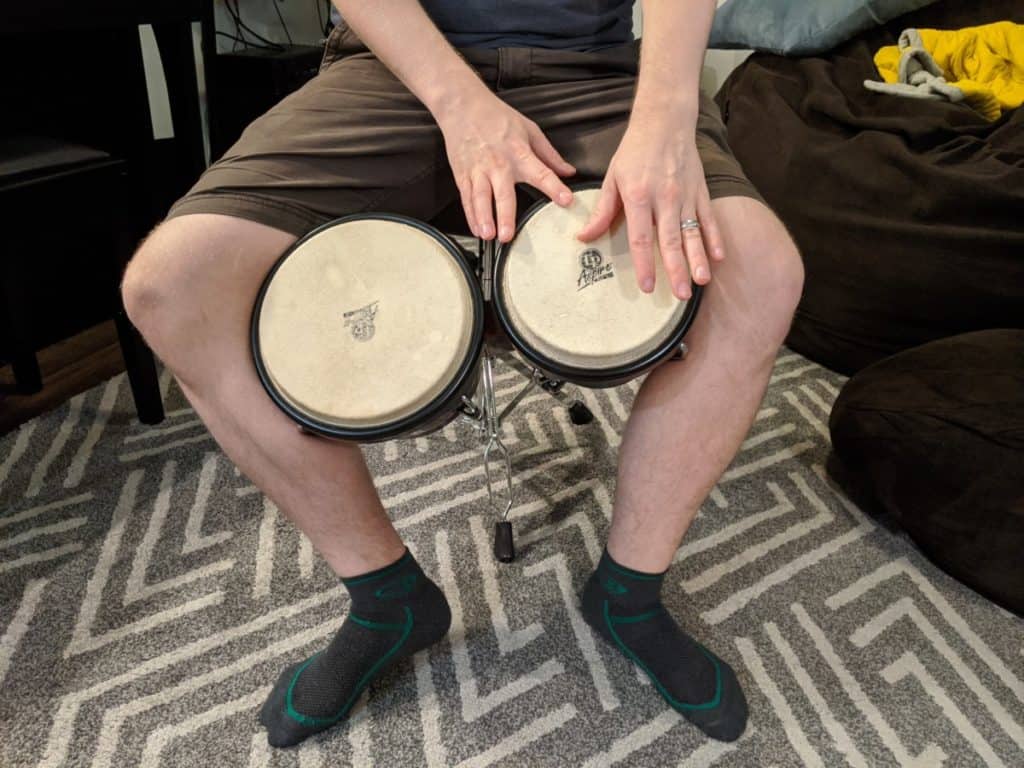
By the way, looking for recording equipment and musical instruments? Check out Sweetwater.com for microphones, monitors, audio interface or any other recording gear that you could ever need. (Affiliate Link)
How Much Do Bongos Cost?
Entry-level bongos range in price from $40 to $90. If you’d like to know more detail about how much bongos cost and what the difference is between $500 bongo drums and $50 bongo drums, make sure and check out my article here.
How Easy Are Bongos To Learn?
The simplicity of the bongos makes them very approachable for a beginner. Within minutes you can play fundamental rhythms.
However, the bongos have a depth that makes them interesting and exciting to play. You don’t have to stop at simple rhythms and be done–you can learn to play complicated and fast rhythms that sound amazing if you are willing to put in the time.
The key to learning bongos is to understand the different sounds and voicings that the drums can make. You can simply hit the drums like you would any beach ball, or you can learn the more advanced rhythms and sounds.
I actually did a basic tutorial on just the basics of how to play the bongos, how to hold them, and how to tune them. Make sure and check that out if you want to get an idea of what the instrument is like to learn:
After that, if you want to see what sounds the bongos are capable of, I also made a short video here to explain the techniques of the bongos can do, and therefore what sounds you can make from the bongos. Hopefully by the end you’ll understand the potential of the bongos.
Didgeridoo
The didgeriwhat?
The didgeridoo is an ancient and beautiful instrument originating from the aborigines in Australia. In essence, it’s typically a hollowed out wooden cylinder.
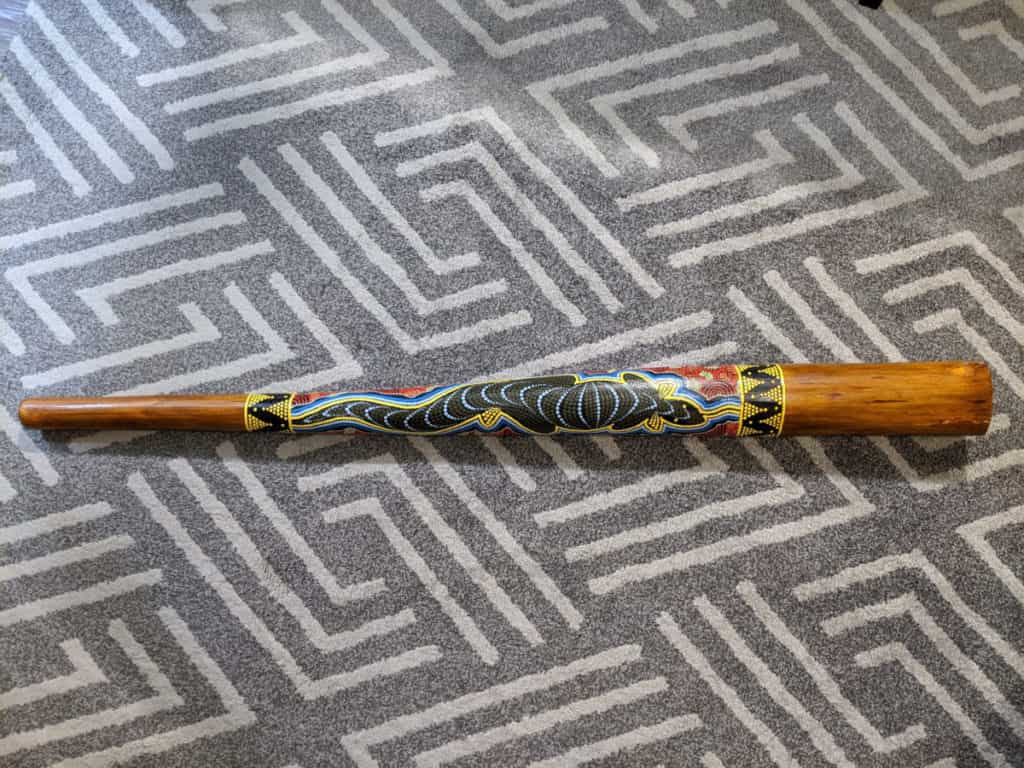
How Much Does A Didgeridoo Cost?
The instrument can be made from any solid material–in fact if you really want to stay inexpensive, any ABS/PVC pipe that is from an inch to 1.5 inches in diameter (25mm-40mm) can be played as a didgeridoo. That means you can play the didgeridoo for less than $10.
Besides ABS/PVC homemade didgeridoos, you can purchase a plastic didgeridoo that looks great and will sound great for beginners. Toca makes an attractive one that you can find here on Amazon.
If you’d like more information about buying and finding a didgeridoo for beginners, I made an easy guide, here.
How Easy Is the Didgeridoo?
What I love about the didgeridoo is that you can learn to play the basics in a week’s time. Some have more difficulty with circular breathing and making a drone than others, but some are able to pick up the basic sounds and techniques in just a week. I actually have MORE information about how long it takes to learn the didgeridoo (with myself as an example) in my post here.
The didgeridoo is accessible to so many, and it’s a very non-judgmental community of players. While some guitarists might make fun of each other for not being able to shred the guitar like they they each other should, didgeridoo players welcome beginners with open arms.
I teach some of the basics of the instrument here in my video. This might give you an idea of what playing the didgeridoo is like and what techniques you’d have to learn:
Tin Whistle
Wow. I love the tin whistle–such a beautiful and sweet instrument.
The tin whistle is a fipple flute comprised of a cylinder with 6 finger holes with a mouthpiece on one end that you blow through to produce the sound.
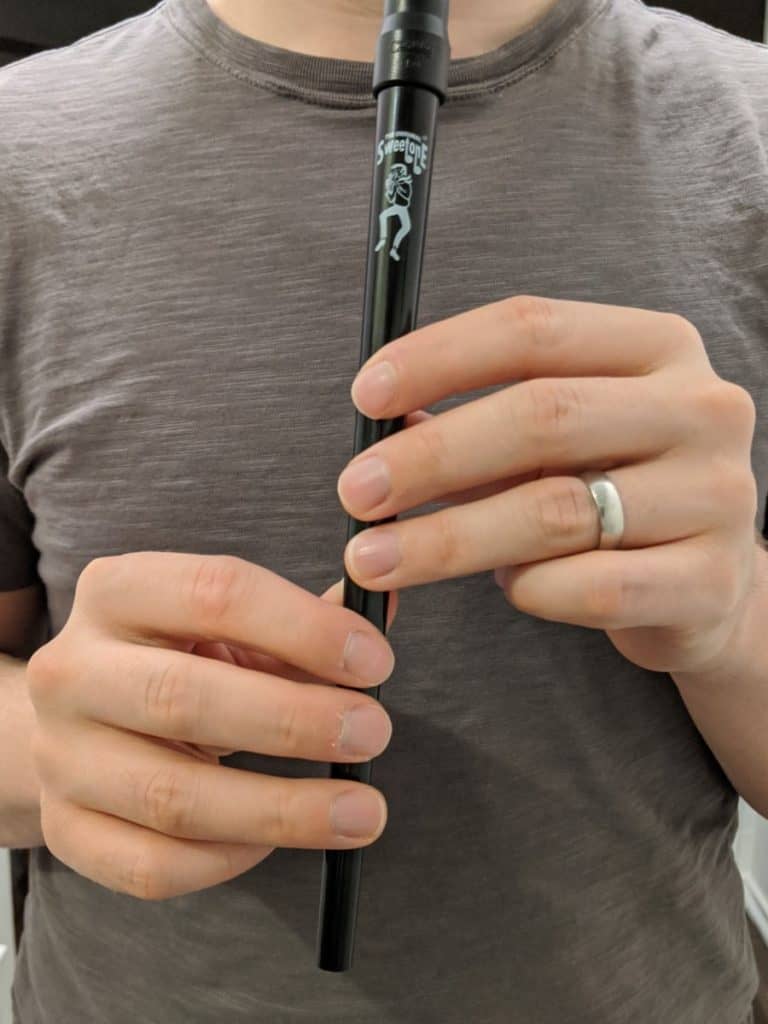
How Much Does A Tin Whistle Cost?
Buying a tin whistle is a beautiful and sweet experience as well! Since you can get a very good quality tin whistle for less then $50. In fact, my Tin Whistle can be purchased for around $15.
Don’t be fooled! Even though this is a very inexpensive instrument it can make spectacular and enchanting music.
Tin Whistle’s entry to mid-level tin whistles range from $10 to $100. If you’re interested, I put together a buying guide for tin whistles that goes into depth on what the differences are between the different quality levels of tin whistles are.
How Easy Is the Tin Whistle?
I love the tin whistle. For many reasons, one big reason is that you can get a beautiful sound without having to perfect technique. A violin player has to practice for months (arguably longer) before they can play a note that doesn’t sound terrible.
A concert flute player (the kind of flute played sideways to the players mouth that you see in a traditional orchestra/band) has to practice for a while before being able to sustain and create sounds that aren’t screechy.
With the tin whistle, you can practice for an hour to make sound, and not many more hours to make good sound!
The reason for this is that many other instruments including flute, trumpet, and others require a special thingamijig called an embouchure. Which isn’t anything fancy, just the muscles and shape of your mouth. Tin whistles benefit from good mouth shape, but it’s much simpler! To get started you simply just blow through the instrument.
So, the tin whistle has that going for it, it’s easy to start making sound.
Past that, the tin whistle has 7 (really 8, and actually more) notes to work with, (a recorder or a trumpet is designed to play 12 notes), therefore the tin whistle has less notes to work with which makes it simpler to learn.
To put this in perspective, a recorder has 10 holes to cover, while a clarinet has 17. The tin whistle only has 6.
In fact, I had never really played the tin whistle although I had one. I spent 30 days studying the tin whistle, and this is where I got in just 30 days of practicing for an hour a day:
This means, that as a beginner, you can learn how to make all the notes and how to play basic songs in a month’s time. (Even less time if you have music experience).
Some have questioned whether the tin whistle is a toy instrument for this reason–it really isn’t–it’s an incredibly versatile if simple instrument that can be used professionally. Need proof? Check out my article that addresses this.
If you’d like more information I wrote an article where I answer the question what is easy about the tin whistle and what is hard. Make sure to check it out, here.
Recorder
The recorder is often glazed over because it is an instrument that many kids learn as part of their schooling.
Although at that point in life the recorder does NOT sound like a beautiful instrument, it has so much potential in the right hands.
How Much Does A Recorder Cost?
The cheap recorders that you got as a kid run for around $5. Nowadays you can get an inexpensive recorder that is fully functional and can make beautiful music for around $15. You can consider the price range to be about the same as the tin whistle.
In fact you can see a pro do a cost comparison between an inexpensive recorder and a professional-quality recorder here:
Is the Recorder Easy To Learn?
I don’t have personal experience learning the recorder besides picking it up a few times. What I do know is the following:
- It’s very easy to start making sound with the recorder
- The recorder is simple enough to learn the basic notes that it’s given to 6-year old children in many schools as a part of learning music
The recorder’s hole configuration is slightly more complicated than the tin whistle, but still relatively simple and easy to learn in comparison to other instruments.
Some musicians play the recorder professionally, it’s definitely an instrument that has depth and potential. The simplicity of the instrument makes it attractive for many people to begin learning music.
Auxiliary Percussion (Shakers, Maracas, Etc)
What is auxiliary percussion? Well, it’s considered percussion that supports the rest of the band (which, to be fair, any percussion instrument is considered a support to the rest of the band in most circumstances).
There are SO many instruments that fit in this category. You can check out several types here at ZZounds.
Examples of auxiliary percussion are:
- Shakers / Maracas
- Tambourine
- Cowbell
- Clave
- Agogo Bells
- Triangle
There are dozens more instruments in this category.
I’ll talk about Shakers as an example and a talking point–don’t skip to the next section just yet! There’s more than you think that can be done with this kind of instrument.
How Much Does Auxiliary Percussion Cost?
Fortunately, this type of instrument is usually very affordable– for example, the Wah Wah shaker from Meinl (see on Amazon) is under $20 at the time of this writing, and there really isn’t much of a reason to pay more than that.
Auxiliary percussion like this can vary in price, but in virtually every case you can find a decent quality instrument under $50, while professional quality auxiliary percussion items can be more than $100.
How Easy Is Auxiliary Percussion To Play?
As far as being able to make a sound, these are some of the easiest instruments to make sound as is possible. Within seconds you will be able to learn how to make sound on any auxiliary percussion instrument.
With some practice, you can learn to keep a beat. After much more practice, you can learn to play solid rhythms that fit perfectly within the music.
This is what isn’t easy about auxiliary percussion. You can’t expect to be given a microphone and a shaker or tambourine and expect to make tight and solid rhythm–it takes practice to internalize the rhythm. In fact, drummers and other percussionists practice with a metronome consistently so they can engrain the beat within their minds and muscle memory.
However, to get to the point where you can keep time, it will take a month of consistent practice. To get super solid it will take much more time–but, if you want to add another instrument to your repertoire that is easy to pick up, make sure and check these instruments out.
Ukulele
To a casual observer’s eye, the ukulele looks like a little guitar, and the concept is very similar, but on closer inspection you’ll find that the ukulele has 4 strings instead of the 6 with a regular guitar.
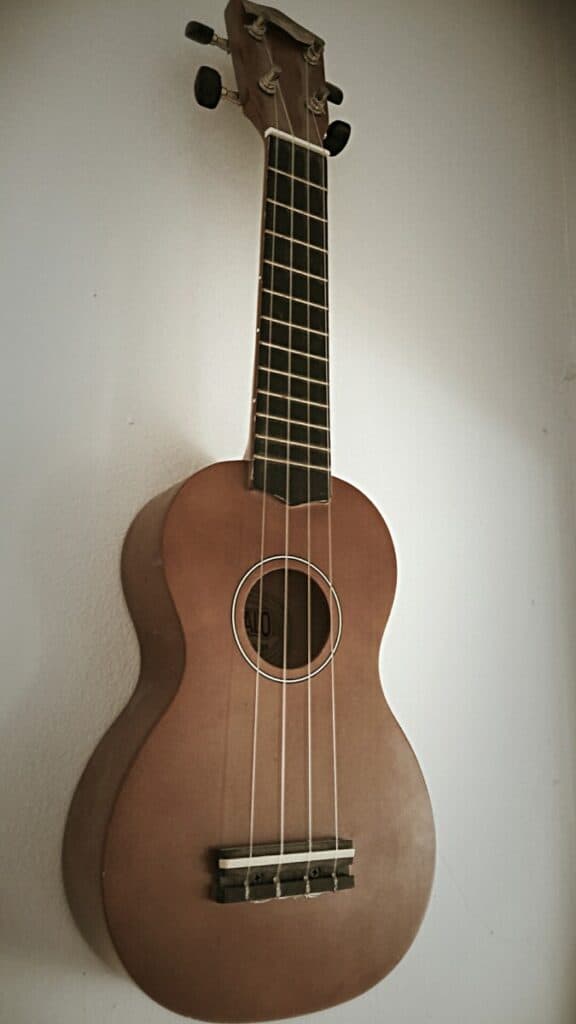
Ukuleles (especially tenor and soprano) also are tuned in a way that is odd for most guitar players: “Re-entrantly”. What does that mean? Well it means that the strings don’t go from lowest to highest from one string to another. The actual lowest string is the 2nd string!
This tuning as well as the shape of the ukulele and the type of strings used gives the ukulele it’s incredible mellow sound that is simply enchanting. I can’t think of a better word–but that word works! Enchanting.
How Much Does A Ukulele Cost?
As far as inexpensive, Ukulele’s are further towards the top of the inexpensive category.
Although ukulele’s bigger cousin guitars can also be found for less than $100, the quality you’ll get with a cheap guitar is very low–so low in fact that it may be counterproductive to practice because it might be more frustrating than it’s worth.
Ukulele’s, however, you can definitely find decent quality soprano and concert ukulele sizes (there are 4 sizes) for under $100 (such as this Luna Tattoo Concert Ukulele from Amazon. This is the concert size and I have the tenor size–but I love this ukulele).
You can also find larger sized ukuleles, but you’ll have to go into the no-name brands, so you may be sacrificing quality–but you’re very likely to find a workable quality ukulele in any size under $100.
Before you go buy the cheapest ukulele, make sure and get the right size. Soprano ukuleles are so small they are difficult to play (for me at least)–and I could barely hold onto the concert size, myself. The tenor ukulele is a comfortable size for me, so you’ll have to adjust to what works for you.
How Easy Is the Ukulele?
So, to be honest, I’d say that ukulele is on the high end of easy. What I mean by that is that it is a rich and dynamic instrument, and it’s actually got some techniques that are tricky to get the hang of!
In other words, it’s not super easy, it’s easier than guitar, but it’s not the easiest instrument out there.
The tuning of the ukulele is a little tricky to get used to (especially for guitar players), and some chord shapes will give you hand cramps just like you experience with guitar.
Ukulele does have some extremely easy chord shapes along with softer nylon strings (in comparison to steel-string guitar), making it easy to learn some basic songs that hang around some very common chords (like Dm, C, G, Em, F, Am…stuff like that).
But there is definitely some challenge here! If you want to learn more about what reasons the ukulele can actually be hard check out my article here.
Kalimba (Thumb Piano)
The kalimba is another beautiful instrument that most people have heard before but didn’t know from which instrument the sound was coming from.
The kalimba, which is similar to the mbira, is a lamellophone, which means that the sound is made by plucking a metal tine (or also called a tongue). The pluck is made louder using a resonant surface or chamber.
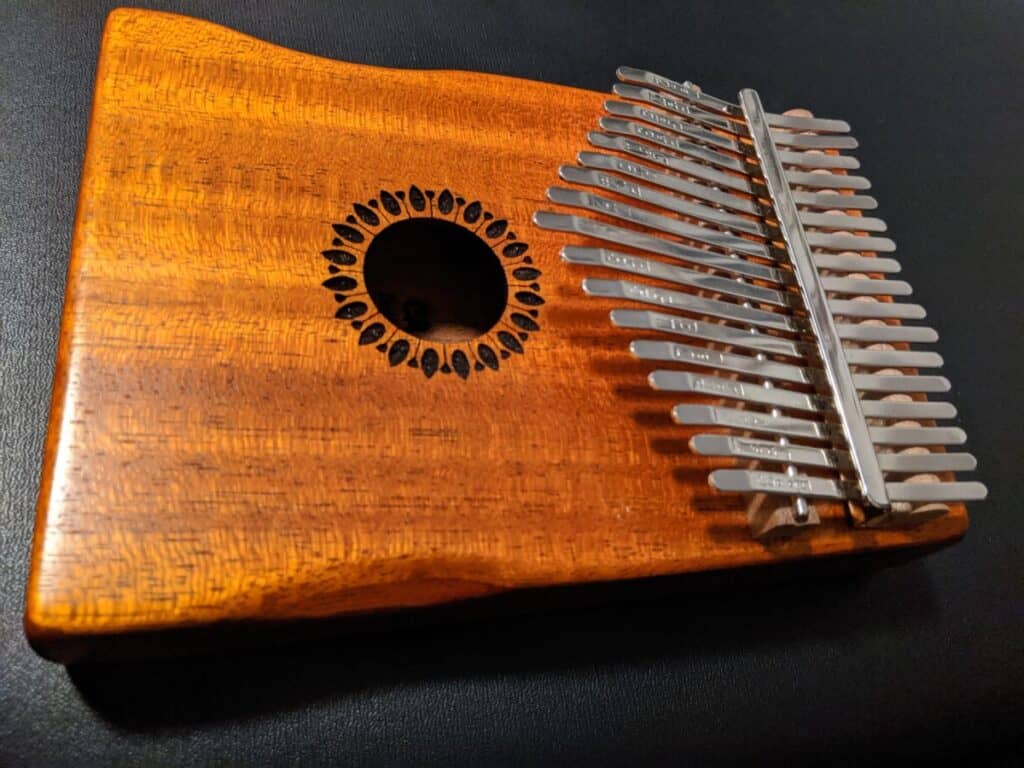
The kalimba is a set of these metal tines arranges in a a triangle shape that you pluck with your thumbs, which is why it’s often called a thumb piano. You can also use your fingers to pluck the tines.
How Much Does a Kalimba Cost?
Me and my wife are weird. We have a rule we’ve set together to only buy gifts for each other (birthdays and Christmas) that are max $30. We do this to reduce stress, and for anything that we want over $30 we work with each other to agree if it’s a good decision.
I’m telling this story because my wife found this kalimba that fit that bill! You can find a beautiful sounding and looking kalimba in the $30 range.
There are larger and more expensive kalimbas as you can imagine, and they range in price from $50 to $150–but don’t fret, you can get your feet wet with a small investment in the $30 range.
How Easy Is the Kalimba?
The kalimba, again, is an incredibly easy instrument to get started–you can learn the basic technique in a few minutes.
If you have some experience playing the piano or other melodic instrument, then the note configuration will feel a little strange, but you’ll get the hang of it quickly.
If you’re a beginner to the kalimba, and especially if you’re a beginner to music in general, it’s important to get a kalimba that has the notes engraved into the tines.
Some kalimbas have no note markings, which makes it easier if you wanted to use a custom tuning. However, if you’re a beginner and if you want to learn quickly and play songs then it’s a good idea to get a kalimba with the notes engraved (look at the picture of my kalimba above for an idea of what that looks like.)
The notes of the kalimba are all visible, which, what I mean by that is that the kalimba is unlike a trumpet or a clarinet where you have to match your mouth shape and wind speed with a certain key configuration on the instrument to make a certain note. A kalimba is like a piano, wherein if you pluck a tine, it will make the same note every time. This is one reason which makes this an easier instrument to get started.
So, the kalimba is easy to get started, but I just recently finished playing the kalimba for 30 days of practicing it, and I learned that to get to the level of those amazing players you see on YouTube, it takes a lot more practice than I’d thought. Playing complicated pieces that sound really good takes a lot of coordination and dexterity.
So, if you’re looking for an inexpensive instrument that’s easy to pick up and make music, the kalimba is an excellent choice. If you’re looking for an instrument that still has depth and subtleties that will keep you engaged for hours on end? Then the Kalimba is still an excellent choice!
Melodica
What on earth is a melodica? Well, you’ve probably seen this instrument but you didn’t know its name. A melodica is a wind-powered instrument controlled by a small keyboard that has an accordion-like sound. It works similar to how a harmonica works.
The player blows into the instrument while pressing the keys of the small keyboard, and then you have music!
It’s not often an instrument you hear in a lot of modern music, but it does show up now and again. You may find it’s an acquired taste, but once you do, it’s a versatile and fun instrument that also has its own depth.
You can see and hear an example of the melodica in “On My Way” by the Melodic:
How Much Does a Melodica Cost?
Melodicas often come in two varieties, 32-key, and 37-key. The 37-key melodica is, as you might expect, more expensive than the smaller melodicas.
You can find many melodicas under $100, but many beginner models are in the $30-$50 range.
Generally, the quality of the instrument increases with the price, as well as the size of the instrument.
How Easy Is the Melodica?
The melodica is primarily played with one hand while you are blowing through the instrument. It requires some breath control and some practice to be able to breathe through the mouthpiece/hose and play the keyboard at the same time.
While strong breath support might take you months of practice, you’ll be able to play the instrument within an afternoon of practice.
Past that, the melodica notes are structured and presented exactly as they are on a piano, which is great! The notes are visually represented–if you push a key and blow enough air, that note is sounded, every time. You don’t have to pick the note out of the air like other wind instruments.
So, one-handed playing, visually represented notes, and basic base technique all together means the melodica is a comparatively easy instrument for starting on.
You’ll get an idea of what learning the melodica from this brief tutorial here:
Harmonica
The western harmonica is a classic folk instrument that you’ll hear in folk music but occasionally in other genres. One of the most famous uses is in the hit song: Love Me Do by the Beatles.
The harmonica works similar to the melodica in that the player blows air through a channel which vibrates a metal tine. The harmonica has several air channels which the player can play into simultaneously creating chords and complex sounds.
How Much Does a Harmonica Cost?
You can buy an entry-level harmonica as low as $10-$25, or a high quality harmonica for $50-$100.
Higher quality (and usually more expensive) harmonicas will have more solid tuning, and will stay in tune longer.
How Easy Is the Harmonica
A child can pick up the harmonica and within moments figure out the basic premise.
There is a bit of technique involved, though. The player has to use their tongue to focus the air in the right air holes. You can’t really see where you’re playing, but instead you have to play by feel, which takes some time to get the hang of.
However, the harmonica only plays one note at a time or at most a couple sound holes at a time. One aspect of piano that makes it hard to play is that you can play multiple notes at a time, even with one hand! However, this is something that makes the harmonica easier to play is that you are only worried about one (or two) notes at a time.
So, in honesty, the harmonica is easy to learn the very basics, but to master the techniques necessary to make good sound and being able to transition cleanly between notes is a bit more difficult.
Beatboxing
You might be wondering how this made it onto this list and not singing! Well, singing is very inexpensive, but it turns out it’s very difficult to sing on pitch for many people if they haven’t tried it, before. Singing on pitch can be learned, but for those who haven’t figured out the knack it’s a huge challenge.
Beatboxing is different, because while not everyone can sing on pitch, virtually everyone can make some sounds with their mouth. The B in word boots–or the K in the word cats–these are sounds that we make every day.
How Much Does It Cost To Beatbox?
This is one of the rare things in life that has already been paid for. Beatboxing is free (to you at least).
How Easy Is It To Beatbox?
If you can talk, you can at least do basic beatboxing. Beatboxing is all about using the sounds the mouth can make to make rhythms, and it turns out that in normal speech we learn how to make a tremendous variety of sounds.
The famous “boots and cats” video on YouTube made the phrase “boots and cats” synonymous with beatboxing.
So, part of the trick is to make sounds with your mouth, the other part is to do that rhythmically.
If you can keep a beat to music (if you are able to tap your foot to the beat of the songs and stay on rhythm), then you already have what it takes. If that’s tricky, then if you look for a metronome and start saying the word “boots” on one beat, “and” on the next beat, “cats” on the third beat, and then “and” once more (and then repeat!) you’ll get the hang of it in just a short while.
If you’re looking for as cheap of an instrument as you can get, as well as a skill that can be learned with a little bit of dedicated learning then beatboxing is a fun hobby for you!
Jaw Harp
Ahh, the jaw harp. When I first started studying the jaw harp I thought I would know everything there was to know in a few days! I was very wrong… the jaw harp is an instrument of surprising depth that’s capable of a huge variety of sounds and is also capable, in the right hands, of fantastic rhythm, and even melodies!
The jaw harp is yet another instrument that is played by plucking a metal tine so that it causes a vibration on a resonant surface.
The jaw harp is played by pressing the jaw harp against your teeth with your mouth slightly open and plucking the tine (or often called the tongue) between your teeth.
How Much Does a Jaw Harp Cost?
Another one of my favorite parts of the jaw harp is that it’s so inexpensive. You can get a beautiful instrument that’s capable of so much for well under $50. I practiced a jaw harp for 30 days and just started to tap the capabilities of the instrument and I bought it for $15.
There are a lot of jaw harps, and some of them are even in the $5 range… I really recommend not getting one of those, though. It’s worth spending a few dollars more for something of better quality. I explain why in my video here:
How Easy Is the Jaw Harp?
The Jaw Harp is a simple instrument and is very simple to play, at least initially. In fact, I show how to play the jaw harp in 20 minutes and I touch many of the basics. Although you can spend an entire month focused on the jaw harp (like I did) and still barely scratch the surface, you can learn quite a bit in just 30 minutes of practice.
Within a week, you’ll be able to play simple rhythms and a variety of different sounds.
If you’d like to watch my video showing how to play the jaw harp, check it out here:
Lap Harp (Music Maker) / Lyre
The Music Maker is a type of lyre (handheld harp) that is made specifically to be a very approachable instrument.
This instrument allows for sheet music to be put underneath the strings so all you have to do is use the plectrum (pick) to pluck the notes that are directly underneath the strings.
This is a RARE quality among instruments that can basically integrate with its own tablature. These instruments are usually well under $100.
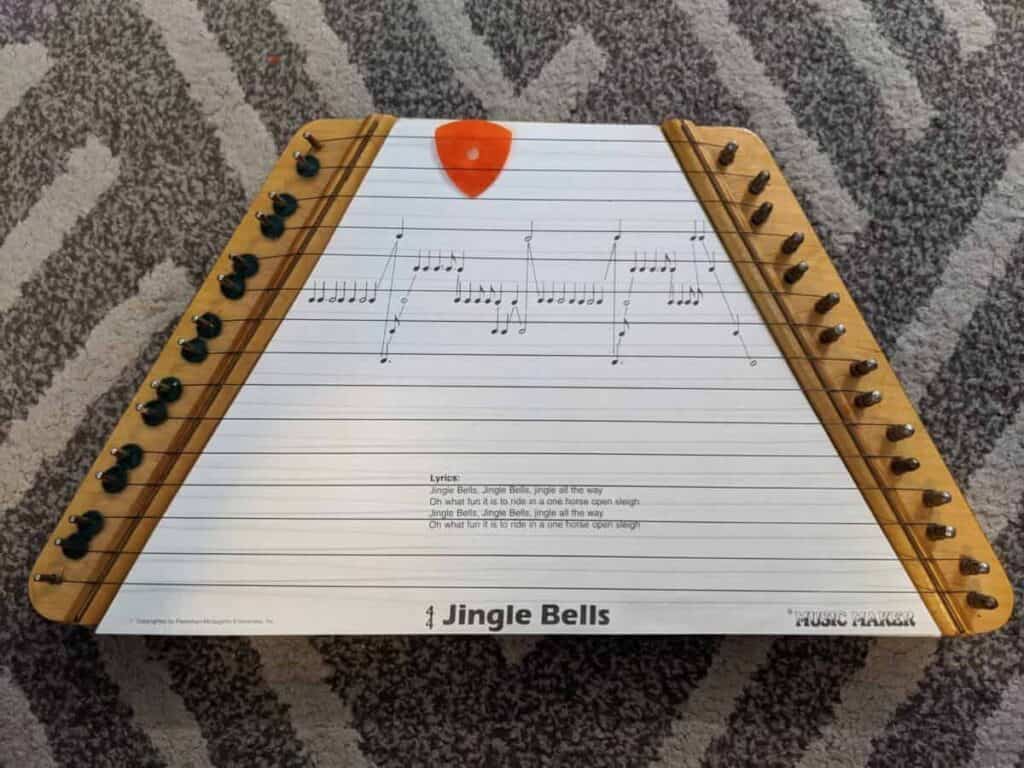
Orba
The Orba (found at ZZounds) is a digital instrument that has tremendous capability. You can play multiple synthetic instruments including melodies and drums. The instrument can be simple or complex which can accommodate a wide range of musical ability.
As of this writing you can pick up an Orba for around $100.
Here it is on YouTube if you want to see it in action:
